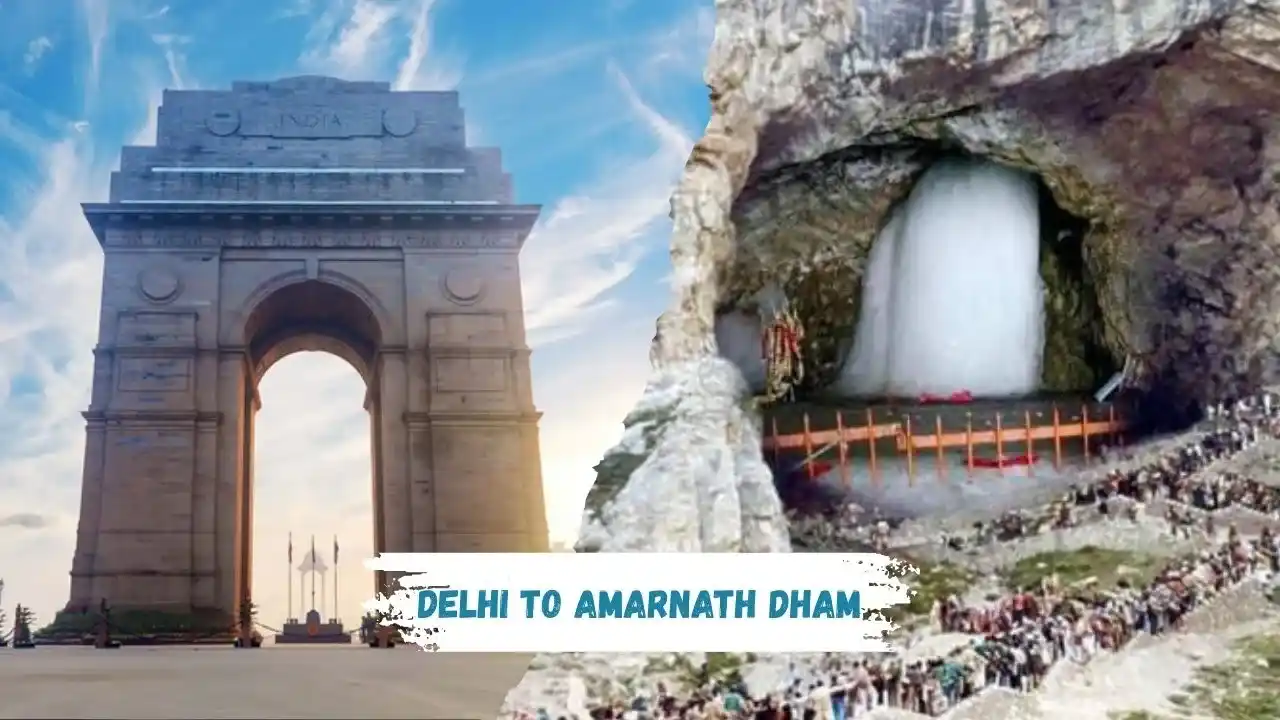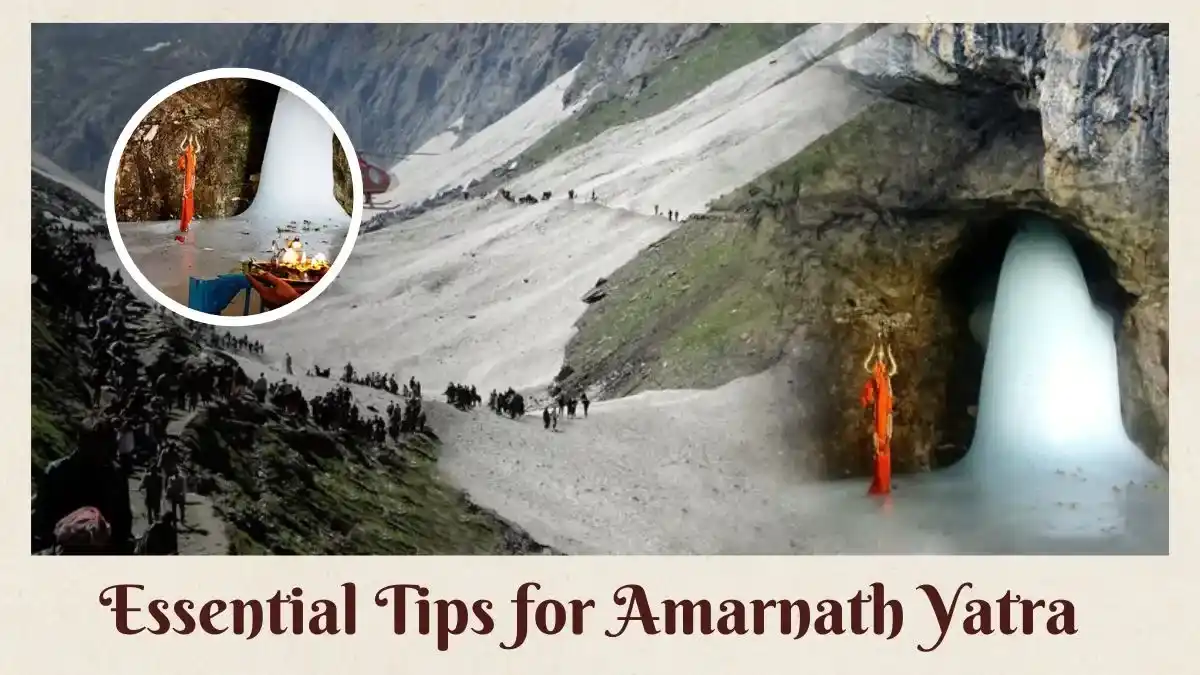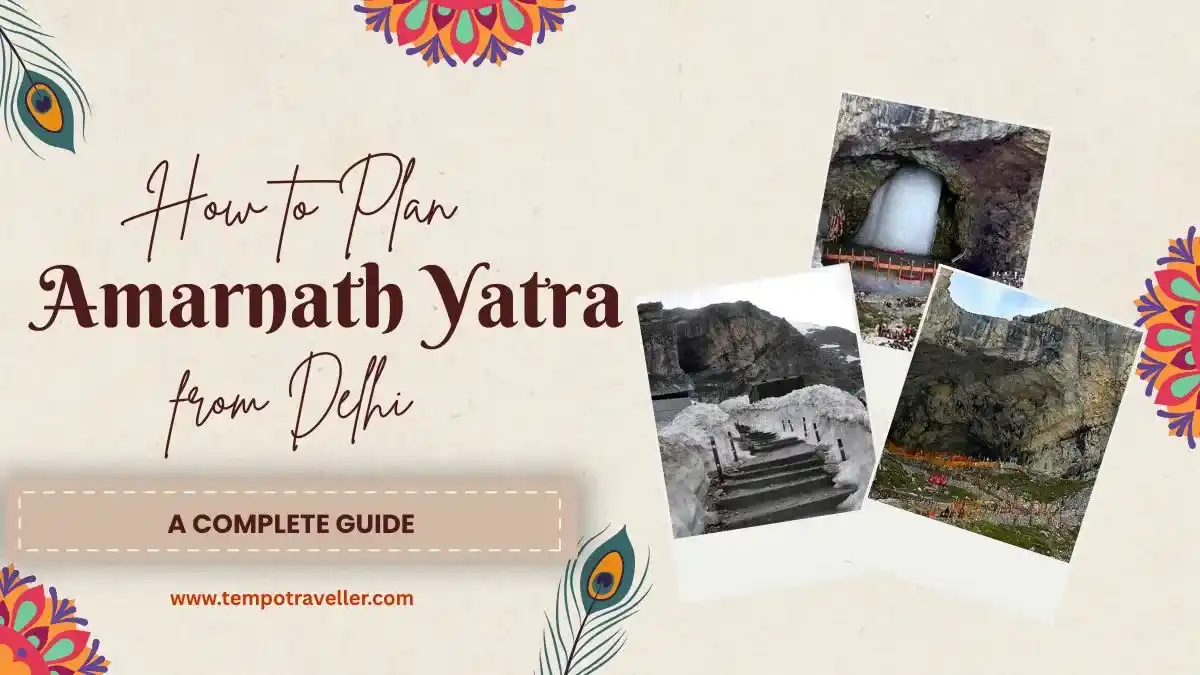Are you planning the Amarnath Yatra in 2025 from Delhi and looking for the most detailed information in one place? You will find everything you need to know in this guide. The Amarnath Yatra is one of India’s most important Hindu pilgrimages. It takes devotees to the Amarnath cave at 3,888 meters in the Himalayas of Jammu and Kashmir, where they face both physical and spiritual challenges.
Last year, over 4.5 lakh pilgrims made it to the cave successfully. The pilgrimage happens every summer, during the month of Shravan which usually falls between late June and August. The cave’s naturally forming ice Shivling is a powerful spiritual representation of Lord Shiva. You will gain the clarity you need from this guide to confidently finish the Amarnath Yatra from Delhi, whether it is trek options, registration process, transportation options, safety precautions and the route from Delhi.
Registration Process for Amarnath Yatra
Registration for the Amarnath Yatra 2025 started on April 14th. That’s when both online and offline registration options opened up for pilgrims from all over India.
● You will need to register individually and that means submitting all the necessary documents. The age limit for registration is 13 to 75 years.
● Pregnant women who are more than six weeks pregnant won’t be allowed to register due to health risks.
● To register online visit the official website of the Shri Amarnathji Shrine Board. Fill in the application form with personal details upload scanned copies of the health certificate ID proof and recent photographs. You will also be asked to verify your mobile number using an OTP and complete the payment of the registration fee online. After verification the Yatra Permit will be issued with a unique QR code.
● Offline registration is also possible at any of the designated branches of Punjab National Bank, Jammu and Kashmir Bank, Yes Bank or State Bank of India. Fill out the form at the counter, submit it with your documents and fee. Each bank branch has a daily quota and your permit will be color-coded based on your route and date. Permit verification happens right there on the spot. It’s a good idea to carry multiple photocopies of your permit and ID proof during the journey. That way, you’ll be prepared for checks at multiple points.
How to Reach Amarnath Dham from Delhi

To reach Amarnath Yatra from Delhi, you have several travel options to choose from. Your first step is to get to either Srinagar or Jammu. That can be done in a few different ways.
By Air
You can take a direct flight from Delhi to Srinagar in just over an hour and a half. From Srinagar Airport, you have to travel by road to reach the base camp or the starting point of the Amarnath Yatra which is Baltal or Pahalgam. You can hire our Airport Pick up Service at Srinagar Airport to travel comfortably. You can choose to trek or take a helicopter to reach the cave.
By Train
The train is a budget friendly option. You can take a train from Delhi to Jammu Tawi Railway Station. Take a rental taxi or buses to reach to Baltal or Pahalgam.
By Road
If you want to travel the 870 kilometers between Delhi and Srinagar entirely by road, you can do that in multiple legs with stops in Ludhiana, Pathankot or Jammu. Then move to the base camps at Baltal. To cover this long journey from Delhi to Srinagar, can book Tempo Traveller on Rent– available in multiple seating options and facilities. It also facilitate you to reach your base camp easily without waiting for other modes of trabsport.
By Helicopter
You can take a helicopter from Neelgrath near Baltal or Pahalgam. That will drop you off close to the Amarnath cave, where a 6 km short trek is required. Booking those helicopters in advance is a good idea and via the official SASB website or through approved helicopter operators. Seats are limited and there’s high demand during Yatra days. It will cost between ₹2000 to ₹6000 for a one way trip.
Amarnath Yatra Trek Routes
There are two routes to Amarnath Cave and both are managed by the Shrine Board.
1) Pahalgam Route
The Pahalgam Route is the traditional and longer route with 39 km trek. The journey starts from Pahalgam and goes through Chandanwari covering distance of 12 km. From Chandanwari to Sheshnag distance is also 12 Km. Cover a distance of 9 km from Sheshnag to Mahagunas and Panchtarni and finally Amarnath Cave after 6 km trekking from Panchtarni. This route is chosen by pilgrims who want to follow the symbolic path of Lord Shiva’s renunciation. Facilities for food and medical aid are available at designated halting points along the way.
2) Baltal Route
The Baltal Route is shorter and steeper with 14 km trek. It starts from Baltal and goes straight to the cave. This can be done in a single day if you are physically fit. It’s ideal for those who want a quicker route to the cave. Helicopter service is available from Baltal to Panchtarni and from there 6 km trek to the cave. Baltal route has fewer halting points and is more demanding physically.
Recent Guidelines and News of Amarnath Yatra

● The Shri Amarnath Shrine Board and the Jammu and Kashmir administration have rolled out some significant updates for the 2025 Amarnath Yatra from Delhi.
● The daily number of pilgrims allowed to trek from Baltal and Pahalgam combined remains capped at 15,000 per day. That’s where drone surveillance and RFID tracking of pilgrims come in to keep the crowds under control.
● This year, safety and coordination will be monitored much more closely through real time satellite tracking. That means a control room will be operating around the clock, with all the forces like military, health, disaster management and police.
● Infrastructure work on the Amarnath Yatri Niwas projects at Ramban and Jammu is moving quickly. Lieutenant Governor’s update on April 4th shows that all that work will be done before the Yatra begins. Those facilities will provide temporary shelter and emergency support to pilgrims when they need during roadblocks or bad weather.
● The first time this year the administration is rolling out an advanced weather alert system that will give you region-specific warnings on rainfall and landslides.
● You’ll also see plastic bans and bio-toilets across the trekking zones to promote environmental sustainability.
● Last year, more than four lakh pilgrims visited the shrine. We expect an even bigger turnout in 2025. Arrangements are reviewed on a weekly basis to prevent disruptions and ensure pilgrims’ safety.
Accommodation Options During Amarnath Yatra
Along the Amarnath Yatra routes, you will find a range of accommodation options. Pilgrims can pitch up in tents provided by private vendors or NGOs at halting points like Chandanwari, Sheshnag and Panchtarni. Those tents come with bedding, blankets and basic meals to keep you going. The cost of a night in a tent can be anywhere between ₹500 and ₹1500 as it depends on where you are also what you need.
If you are looking for a bit more comfort, hotels and guesthouses are available in Pahalgam, Baltal and Srinagar. Budget hotels start at ₹1500 a night, while the fancier ones can cost up to ₹5000. You can also get free meals at community kitchens or langars at various points along the Yatra. These are run by charitable organizations. Booking ahead, especially during peak dates is a very good idea.
Also Read: A Trip to Kedarnath from Dehradun
Essential Tips for Amarnath Yatra

● Get physically prepared at least a month before the Yatra by walking and breathing exercises. The trek is high altitude and steep climb requires stamina and endurance.
● Carry enough woollen clothes like thermal wear jackets gloves socks and caps as it can be zero degree even in July.
● You have to walk through the uneven path and slippery icy tracks so you need a proper trekking shoes with good grip to walk.
● Always keep your original ID proof, Yatra Permit and Health Certificate safely in a waterproof pouch.
● Carry basic medicines for cold, fever, body pain and altitude sickness.
● Keep dry fruits, glucose tablets, energy bars and reusable water bottles with you always.
● Use a flashlight or headlamp after sunset as there is no electricity on the trekking path.
● Avoid alcohol, smoking and plastic bags during the journey.
● Follow all instructions by local authorities, security personnel and Shrine Board volunteers.
● In case of bad weather or health issues seek help at the nearest medical station or camp.
